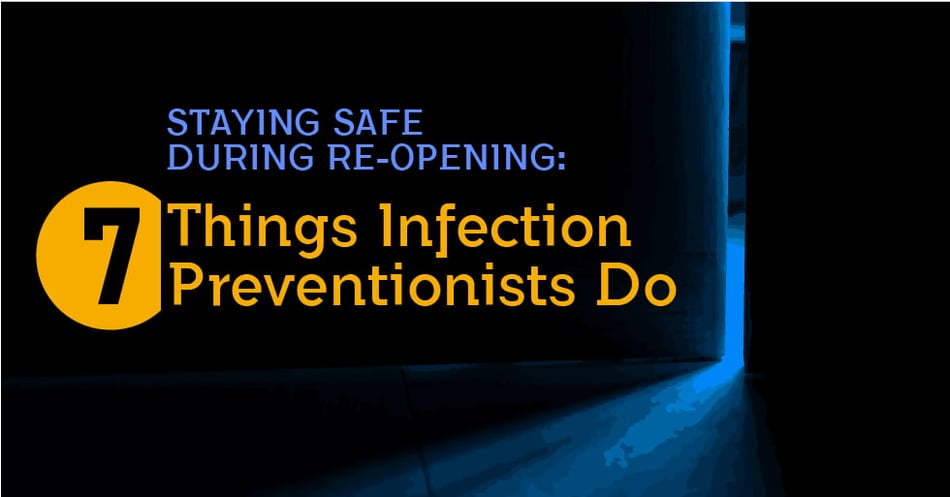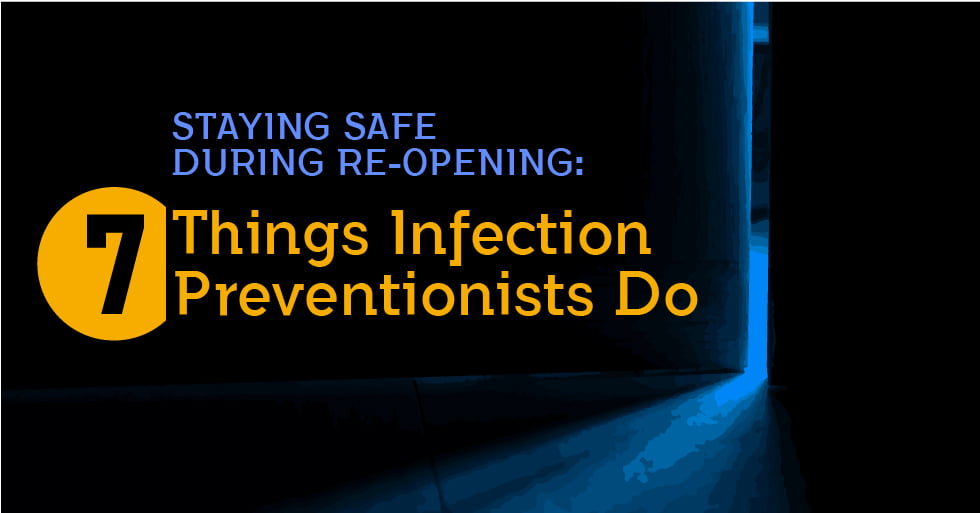Staying Safe During Re-Opening: 7 Things IPs Do


There are no better professionals to emulate than infection preventionists during this time of transition between social distancing and returning to the new normal. These are skilled healthcare workers that know what it takes to keep infections from spreading - or from infecting in the first place. What can we learn from these healthcare professionals as we return to work and life after stay-at-home orders?
After decades of intense work, including data collections, observations, trials, and studies, there are many infection prevention protocols in place that help keep patients safe every day. Here are some of the most important, and how their experience can help you as you venture back out to work and life after sheltering in place.
#1 Make it Easy to Be Clean
Infection preventionists know - and not just from common sense, but from piles of data collection - that folks are more likely to follow cleanliness protocols if it's easy. What does this mean? It means you have to make the supplies plentiful, accessible, and visible. While cleaning supplies can be hard to come by these days, it is important to have what you and your families needs where they need it. Keep a bottle of hand sanitizer right at the front door (what the infection preventionist would call the "donning and doffing area"), even going so far as to place it right in the path of incoming traffic on it's own table or chair. This kind of visual cue helps us when we have our minds occupied with other thoughts. Keep supplies in your car, your purse or briefcase, and at your work station. And don't forget to keep surfaces as clear as possible - it's much easier to wipe a surface that is not cluttered.
#2 Choose Supplies Wisely
Cleaning supplies are important when you are trying to contain an infection. In this case, you are trying to keep an infection from entering and staying in your home. While experts agree that wiping down all items that come into the house is not necessary, it is important to use the right product for those items you do need to clean. Porous surfaces can be sprayed with a fabric disinfectant with a virucide. Hard surfaces should also be cleaned with a product with a virucide claim - the label should clearly note that it kills 99.9% of viruses with an EPA registration.
#3 Wash Your Hands
It is getting easier to get the supplies we need to disinfect our hands and surfaces, but it can still be difficult. The good news is that simple soap and water is all you need for keeping your hands clean. Follow the CDC guidelines for how to wash - just remember to wash for at least 20 seconds! The WHO uses the "5 Moments to Hand Hygiene" to guide healthcare workers. For us at home or at work, these moments would be after touching common property or surfaces, before eating, after using the restroom, and after returning home. When we are sick or are vulnerable, we need to wash our hands more often.
#4 Wear Your Mask Properly
Infection preventionists know all about PPE, or personal protective equipment. They know that when they put on their gown, gloves, and mask, they are protecting vulnerable patients from something they may be carrying, not just helping keep an infection contained to one room. So when you put on your cloth mask before going to work or to the store, you are taking an extra step to protect those around you from an infection you may have but are not aware of yet. This is particularly important with COVID-19, as you are infectious for many days before the first symptom arrives. So wear that mask correctly, when you are in enclosed spaces, and where social distancing is difficult. Following these guidelines for proper care of your cotton mask.
#5 Checklists
Thanks to the pioneering work of Dr. Peter Provonost at Johns Hopkins University, we know that all healthcare personnel do better when there are checklists for each procedure. Doctors and nurses are extremely busy and often have cognitive overload with all the issues going on around them. To make things safe and consistent, checklists are developed for everything from taking blood to transplanting a heart. In our case, we can learn from infection preventionists by making checklists to use to make sure we don't forget to take the steps needed to stay safe. Make a checklist for what to take with you to the store: Mask, hand sanitizer, wipes, etc. Make a checklist for what to do as soon as you get home: Remove shoes, wipe down bags, wash hands, etc. It's easy to forget a step when you do it over and over again, so a checklist can keep you on track. This category can also include schedules: Just like a hospital has a schedule for how often a room is cleaned, you should also have a similar schedule.
#6 Culture of Support
Infection preventionists have to have excellent people skills, since telling someone they are not clean enough or following the rules can be really touchy. Try to do what these healthcare professionals do: Create a culture of support at home where it is ok to remind someone to wash their hands and ok to need to be reminded, and ok to remind each other to wear a mask. We're all in this together, and we all have things on our mind, so it's important to not create a culture where mistakes are met with anger.
#7 Advanced Technologies
What about the advanced technologies used by infection preventionists and their hospitals? Do we need to deploy them in our homes and work as well? Experts agree we don't need these intensive approaches in our homes. Our workplaces, however, should consider some of these technologies to prepare for future outbreaks. Now that we have all been reminded that pandemics are not a thing of the past, we need to prepare for the future. Work sites that serve many individuals, including recreation, education, and social services, should consider some of the technologies that have been reserved for healthcare up to now. Even today, some places are using UV technologies at the end of the day (what healthcare would call "terminal cleaning." A more permanent solution would be continuous sanitizers, such as preventive biocidal surfaces, which can constantly be reducing the amount of pathogens on surfaces such as tables, grab bars, molded seats, armrests, and other high-touch surfaces. Many companies and community locations are beginning to see the value (and return on investment) of these products.
For some of us, leaving sheltering-in-place and stay-at-home orders can be a cause for anxiety, while others may be chomping at the bit to resume normal activities. Regardless of where you are on this spectrum of emotions, the safety precautions are the same: Do what the IPs do. We are all infection preventionists now.
![EOScu Logo - Dark - Outlined [07182023]-01](https://blog.eoscu.com/hubfs/Eoscu_June2024/Images/EOScu%20Logo%20-%20Dark%20-%20Outlined%20%5B07182023%5D-01.svg)





